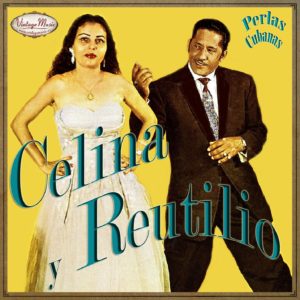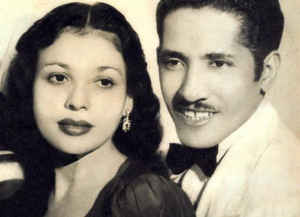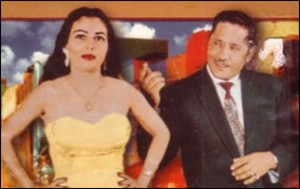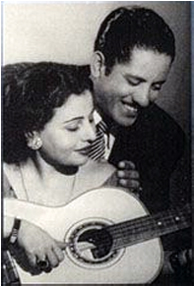 CELINA Y REUTILIO: SU IMPACTO EN LA MÚSICA GUAJIRA CUBANA.
CELINA Y REUTILIO: SU IMPACTO EN LA MÚSICA GUAJIRA CUBANA.
Nace Celina González Zamora en la localidad de Nueva Luisa en Jovellanos, provincia de Matanzas el 16 de marzo de 1928. De padres campesinos, cuando Celina era niña, sus padres y hermanos cantaban en los saraos familiares de fin de semana. Ángela, tocando el tres y cantando y Jesús, el laúd. Celina aprende la base melódica y rítmica del cante guajiro, y de su madre la devoción, por las religiones criollas de Cuba, y de los orishas: Ochún, Babalú Ayé, Changó y Yemayá.
Durante su infancia, su familia mudó a Santiago de Cuba. Gracias a la radio y a su predilección por el sonido punto cubano comenzó a improvisar alguna que otra décima y cuarteta, hacia 1943 conoce al que va a ser el amor de su vida, Reutilio.
Reutilio Domínguez Terrero nacido en Guantánamo en Abril 4, 1921 siendo guitarrista, compositor y cantante. Reutilio destacó cantando en una emisora de radio en Guantánamo.
El dúo se hace conocido en Santiago de Cuba. Finalmente, en 1947 hacen su debut en una emisora de radio, la CMKR.
Mas trade ya en la Habana hacen su debut Celina y Reutilio componiendo un número que se convierte en insignia del dúo: “A Santa Bárbara”, conocido también como “Que viva Changó”. El éxito de ésta guaracha fue inmediata y rotunda.
Con esta composición Celina y Reutilio rompen con una vieja separación que existía entre la música guajira y la música afro, establecen una nueva fusión donde la métrica, o sea, la décima hispánica y el estilo del punto guajiro, se mantienen, pero la letra se refiere a temas del patrimonio cultural del continente negro. La acogida del público se debe no solo a lo novedoso de la tonada sino quizá a varias otras razones. El dúo combinaba la “restallante” voz de Celina, como se la ha llamado, con el sonido producido por Reutilio, que parecía provenir no de una sino de dos o más guitarras. Vale la pena ahondar un poco sobre esto último.
El éxito de Celina y Reutilio en Radio Cadena Suaritos pronto les facilita un contrato con una radiodifusora de alcance nacional, la RHC, Cadena Azul, a la que se trasladan de inmediato, comenzando además a grabar los números favoritos del público. La primera grabación de Celina y Reutilio fue A Santa Bárbara, en la que contaron con el piano del compositor y arreglista Obdulio Morales y el bongó de otro distinguido percusionista habanero conocido como Papá Gofio.
http://youtu.be/HlMsZ8mTGHs
En poco tiempo Celina y Reutilio se convirtieron en favoritos nacionales. La fórmula de combinar las décimas y cuartetas típicas del cantar guajiro con temas de las deidades de los panteones yorubas y congos del pasado africano tuvo gran respuesta del público, y el dúo comenzó a producir toda una serie de números similares como “A la reina del mar”, “El hijo de Elegua”, “A la caridad del Cobre” y otros. Además grabaron una cantidad de música guajira y son montuno de otros autores, como “Lágrimas negras”, “Me tenían amarrao con P” –compuesto por Ñico Saquito–, “El cuarto de Tula” y muchos más.
El próximo capítulo es el de los viajes al extranjero. Celina y Reutilio visitan Nueva York, donde se presentan en el Teatro Puerto Rico, en los años cincuenta, acompañados de Beny Moré; luego viajan a República Dominicana, donde su música era conocida desde que transmitían por CMKR en Santiago de Cuba, en 1947; y regresan a Nueva York en compañía del cantante de danzones Barbarito Diez.
Las tonadas de Celina y Reutilio comienzan a circular por países de la cuenca del Caribe; en particular, Colombia, Venezuela y República Dominicana. Uno de sus números, grabado en una época en que la música guajira daba señas de flaqueza en su popularidad, Yo soy el punto cubano, se convierte junto con, A Santa Bárbara en otro legendario éxito de Celina y Reutilio, que recorre varios países de América Latina.
La colaboración de Celina y Reutilio duró hasta su separación en 1964. Reutilio falleció en 1971. Entre 1964 y 1980 Celina González prosiguió su carrera como solista. A partir de 1980 comienza una nueva etapa en la carrera de Celina. Su hijo Lázaro Reutilio terminaba sus clases formales de música y madre e hijo deciden lanzar una nueva versión de Celina y Reutilio. Apoyándose en el elenco musical del programa de música campesina “Palmas y Cañas”, el nuevo Celina y Reutilio ya no es un dúo sino un conjunto moderno de música guajira y son montuno, con Celina y su hijo Reutilio como las voces estelares.
Celina y Reutilio triunfan también en Europa, donde han cosechado éxitos en el Reino unido, donde es conocida como, “Queen of Cuban Country Music”, en Suecia, Francia y Grecia. Celina ha incursionado en las canciones de la Nueva Trova, particularmente en la obra de Silvio Rodríguez, Girón; además, ha trabajado con los grupos Manguaré y Adalberto Álvarez y su son, con quienes grabó dos discos de larga duración”.
Celina ha influido sobre un número creciente de cantoras campesinas dentro y fuera de Cuba. Su impacto en la música cubana es ampliamente reconocido. Como ha escrito Alejandro Ulloa, Celina es a la música guajira, lo que Celia Cruz ha sido para la guaracha y el son.
 CELINA Y REUTILIO: THEIR IMPACT ON CUBAN MUSIC GUAJIRA.
CELINA Y REUTILIO: THEIR IMPACT ON CUBAN MUSIC GUAJIRA.
Celina González Zamora was born in the town of Nueva Luisa in Jovellanos, province of Matanzas on March 16, 1928. Of peasant parents, when Celina was a child, her parents and siblings sang in family weekend parties. Angela, playing the three and singing and Jesus, the lute. Celina learns the melodic and rhythmic basis of cajun guajiro, and of her mother’s devotion, by the creole religions of Cuba, and of the orishas: Ochún, Babalú Ayé, Changó and Yemayá.
During his childhood, his family moved to Santiago de Cuba. Thanks to the radio and his predilection for the Cuban point sound he began to improvise some tenths and quartets, around 1943 he meets the one who will be the love of his life, Reutilio.
Reutilio Domínguez Terrero born in Guantánamo on April 4, 1921 as a guitarist, composer and singer. Reutilio highlighted singing on a radio station in Guantánamo.
The duo becomes known in Santiago de Cuba. Finally, in 1947 they make their debut on a radio station, the CMKR.
More trade already in Havana makes its debut Celina and Reutilio composing a number that becomes the duo’s logo: “A Santa Bárbara”, also known as “Que viva Changó”. The success of this guaracha was immediate and resounding.
With this composition Celina and Reutilio break with an old separation that existed between Guajira music and Afro music, they establish a new fusion where the metric, that is, the Hispanic tenth and the style of the guajiro point, remain, but the lyrics are refers to issues of the cultural heritage of the black continent. The reception of the public is due not only to the novelty of the tune but perhaps to several other reasons. The duo combined the “crackling” voice of Celina, as it has been called, with the sound produced by Reutilio, which seemed to come not from one but from two or more guitars. It is worthwhile to delve a bit about this last.
https://youtu.be/wrVQTPZfcNw
The success of Celina and Reutilio in Radio Cadena Suaritos soon facilitates a contract with a national radio broadcaster, the RHC, Cadena Azul, to which they move immediately, also beginning to record the favorite numbers of the public. The first recording of Celina and Reutilio was A Santa Bárbara, which featured the piano of the composer and arranger Obdulio Morales and the bongo of another distinguished Havana percussionist known as Papa Gofio.
In a short time Celina and Reutilio became national favorites. The formula of combining the tenths and quartets typical of Guajiro singing with themes of the deities of the Yoruba and Congos pantheons of the African past had great response from the public, and the duo began to produce a whole series of similar numbers such as “A la reina del mar “,” El hijo de Elegua “,” A la charidad del Cobre “and others. They also recorded a quantity of Guajira music and are montuno of other authors, such as “Lágrimas negras”, “They had me tied with P” -composed by Ñico Saquito-, “El cuarto de Tula” and many more.
The next chapter is that of travel abroad. Celina and Reutilio visit New York, where they perform at the Puerto Rico Theater in the 1950s, accompanied by Beny Moré; then they travel to the Dominican Republic, where their music was known since they were broadcast by CMKR in Santiago de Cuba, in 1947; and they return to New York in the company of danzón singer Barbarito Diez.
The tunes of Celina and Reutilio begin to circulate in countries of the Caribbean basin; in particular, Colombia, Venezuela and the Dominican Republic. One of his numbers, recorded at a time when Guajira music showed signs of weakness in its popularity, I am the Cuban point, becomes along with, A Santa Bárbara in another legendary success of Celina and Reutilio, which runs through several countries of Latin America.
The collaboration of Celina and Reutilio lasted until their separation in 1964. Reutilio died in 1971. Between 1964 and 1980 Celina González continued her solo career. From 1980 a new stage in the career of Celina begins. His son Lázaro Reutilio finished his formal music classes and mother and son decided to release a new version of Celina and Reutilio. Relying on the musical cast of the peasant music program “Palmas y Cañas”, the new Celina and Reutilio is no longer a duo but a modern set of guajira music and montuno, with Celina and her son Reutilio as the star voices.
Celina and Reutilio also triumph in Europe, where they have achieved success in the United Kingdom, where it is known as “Queen of Cuban Country Music” in Sweden, France and Greece. Celina has dabbled in the Nueva Trova songs, particularly in the work of Silvio Rodríguez, Girón; In addition, he has worked with the groups Manguaré and Adalberto Álvarez and his son, with whom he recorded two long-playing records “.
Celina has influenced an increasing number of peasant singers inside and outside of Cuba. Its impact on Cuban music is widely recognized. As Alejandro Ulloa has written, Celina is a guajira music, what Celia Cruz has been for the guaracha and son.
Agences/ Wiki/ Celina Y Reutilio/ Internet Photos/ YouTube/ Extractos/ Arnoldo Varona/ www.TheCubanHistory.com
THE CUBAN HISTORY, HOLLYWOOD.





